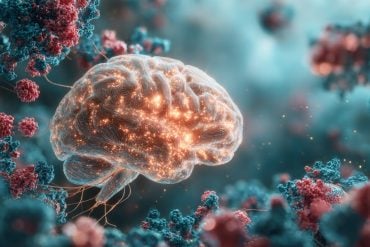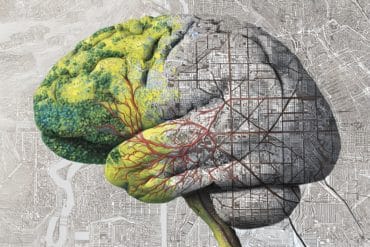Summary: A new study reveals the neurobiological effects of social isolation in mice. Researchers report a neurochemical called tachykinin is overproduced during long term social isolation, leading to increased aggression and fear.
Source: California Institute of Technology.
Chronic social isolation has debilitating effects on mental health in mammals–for example, it is often associated with depression and post-traumatic stress disorder in humans. Now, a team of Caltech researchers has discovered that social isolation causes the build-up of a particular chemical in the brain, and that blocking this chemical eliminates the negative effects of isolation. The work has potential applications for treating mental health disorders in humans.
The work, led by postdoctoral scholar Moriel Zelikowsky, was done in the laboratory of David J. Anderson, Seymour Benzer Professor of Biology, Tianqiao and Chrissy Chen Leadership Chair, Howard Hughes Medical Institute Investigator, and director of the Tianqiao and Chrissy Chen Institute for Neuroscience. A paper describing the research appears in the May 17 issue of the journal Cell.
Confirming and extending previous observations, the researchers showed that prolonged social isolation leads to a broad array of behavioral changes in mice. These include increased aggressiveness towards unfamiliar mice, persistent fear, and hypersensitivity to threatening stimuli. For example, when encountering a threatening stimulus, mice that have been socially isolated remain frozen in place long after the threat has passed, whereas normal mice stop freezing soon after the threat is removed. These effects are seen when mice are subjected to two weeks of social isolation, but not to short-term social isolation–24 hours–suggesting that the observed changes in aggression and fear responses require chronic isolation.
In a previous study of the Drosophila fly, the Anderson laboratory had discovered that a particular neurochemical called tachykinin plays a role in promoting aggression in socially isolated flies. Tachykinin is a neuropeptide, a short protein molecule that is released from certain neurons when they are activated. Neuropeptides bind to specific receptors on other neurons, altering their physiological properties and thereby influencing neural circuit function.
To investigate whether the role of tachykinin in controlling social isolation-induced aggression might be evolutionarily conserved from insects to mammals, Anderson’s team turned to laboratory mice. In mice, the tachykinin gene Tac2 encodes a neuropeptide called neurokinin B (NkB). Tac2/NkB is produced by neurons in specific regions of the mouse brain such as the amygdala and hypothalamus, which are involved in emotional and social behavior.
The researchers found that chronic isolation leads to an increase in Tac2 gene expression and the production of NkB throughout the brain. However, administration of a drug that chemically blocks NkB-specific receptors enabled the stressed mice to behave normally, eliminating the negative effects of social isolation. Conversely, artificially increasing Tac2 levels and activating the corresponding neurons in normal, unstressed animals led them to behave like the stressed, isolated animals.
The researchers also inhibited the function of Tac2 and its receptors in multiple specific brain regions. They found that suppressing the Tac2 gene in the amygdala eliminated the increased fear behaviors, but not aggression, while conversely suppressing the gene in the hypothalamus eliminated increased aggression but not persistent fear. The results imply that Tac2 must increase in different brain regions to produce the various effects of social isolation.

“The approach used here allowed us both to compare the effects of different manipulations of Tac2 signaling in the same brain region, as well as to compare the effects of the same manipulation across different brain regions,” says Anderson. “The rich data set generated by these experiments revealed how this neuropeptide acts globally across the brain to coordinate diverse behavioral responses to social isolation stress.”
Though the work was done in mice, it has potential implications for understanding how chronic stress affects humans.
“Humans have an analogous Tac2 signaling system, implying possible clinical translations of this work,” says Zelikowsky. “When looking at the treatment of mental health disorders, we traditionally focus on targeting broad neurotransmitter systems like serotonin and dopamine that circulate widely throughout the brain. Manipulating these systems broadly can lead to unwanted side effects. So, being able to precisely and locally modify a neuropeptide like Tac2 is a promising approach to mental health treatments.”
The paper is titled “The Neuropeptide Tac2 Controls a Distributed Brain State Induced by Chronic Social Isolation Stress.” In addition to Zelikowsky and Anderson, other Caltech co-authors include research technician May Hui (BS ’16); Tomomi Karigo and Mario Blanco, postdoctoral scholars in biology & biological engineering; postdoctoral fellow Andrea Choe (PhD ’12); graduate student Bin Yang; research associate Keith Beadle; Viviana Gradinaru (BS ’05), Assistant Professor of Biology and Biological engineering, Heritage Medical Research Institute Investigator, and director of the Center for Molecular and Cellular Neuroscience; and Benjamin Deverman, former director of the CLOVER resource center and now at the Broad Institute of MIT and Harvard.
Funding: Funding was provided by the National Institute of Mental Health, the Gordon and Betty Moore Foundation, the Ellison Medical Foundation, the Simons Foundation, the Brain & Behavior Research Foundation, L’oréal USA, and the Howard Hughes Medical Institute.
Source: Lori Dajose – California Institute of Technology
Publisher: Organized by NeuroscienceNews.com.
Image Source: NeuroscienceNews.com image is credited to Maayan Harel.
Original Research: Open access research for “The Neuropeptide Tac2 Controls a Distributed Brain State Induced by Chronic Social Isolation Stress” by Moriel Zelikowsky, May Hui, Tomomi Karigo, Andrea Choe, Bin Yang, Mario R. Blanco, Keith Beadle, Viviana Gradinaru, Benjamin E. Deverman, and David J. Anderson in Cell. Published May 17 2018.
doi:10.1016/j.cell.2018.03.037
[cbtabs][cbtab title=”MLA”]California Institute of Technology “How Social Isolation Transforms the Brain.” NeuroscienceNews. NeuroscienceNews, 17 May 2018.
<https://neurosciencenews.com/neurobiology-social-isolation-9072/>.[/cbtab][cbtab title=”APA”]California Institute of Technology (2018, May 17). How Social Isolation Transforms the Brain. NeuroscienceNews. Retrieved May 17, 2018 from https://neurosciencenews.com/neurobiology-social-isolation-9072/[/cbtab][cbtab title=”Chicago”]California Institute of Technology “How Social Isolation Transforms the Brain.” https://neurosciencenews.com/neurobiology-social-isolation-9072/ (accessed May 17, 2018).[/cbtab][/cbtabs]
Abstract
The Neuropeptide Tac2 Controls a Distributed Brain State Induced by Chronic Social Isolation Stress
Highlights
•Chronic social isolation stress (SIS) causes a pervasive change in brain state
•SIS broadly upregulates expression of Tac2/NkB in multiple brain regions
•Tac2 upregulation is necessary and sufficient for behavioral influences of SIS
•NkB acts locally in different brain areas to orchestrate behavioral effects of SIS
Summary
Chronic social isolation causes severe psychological effects in humans, but their neural bases remain poorly understood. 2 weeks (but not 24 hr) of social isolation stress (SIS) caused multiple behavioral changes in mice and induced brain-wide upregulation of the neuropeptide tachykinin 2 (Tac2)/neurokinin B (NkB). Systemic administration of an Nk3R antagonist prevented virtually all of the behavioral effects of chronic SIS. Conversely, enhancing NkB expression and release phenocopied SIS in group-housed mice, promoting aggression and converting stimulus-locked defensive behaviors to persistent responses. Multiplexed analysis of Tac2/NkB function in multiple brain areas revealed dissociable, region-specific requirements for both the peptide and its receptor in different SIS-induced behavioral changes. Thus, Tac2 coordinates a pleiotropic brain state caused by SIS via a distributed mode of action. These data reveal the profound effects of prolonged social isolation on brain chemistry and function and suggest potential new therapeutic applications for Nk3R antagonists.






